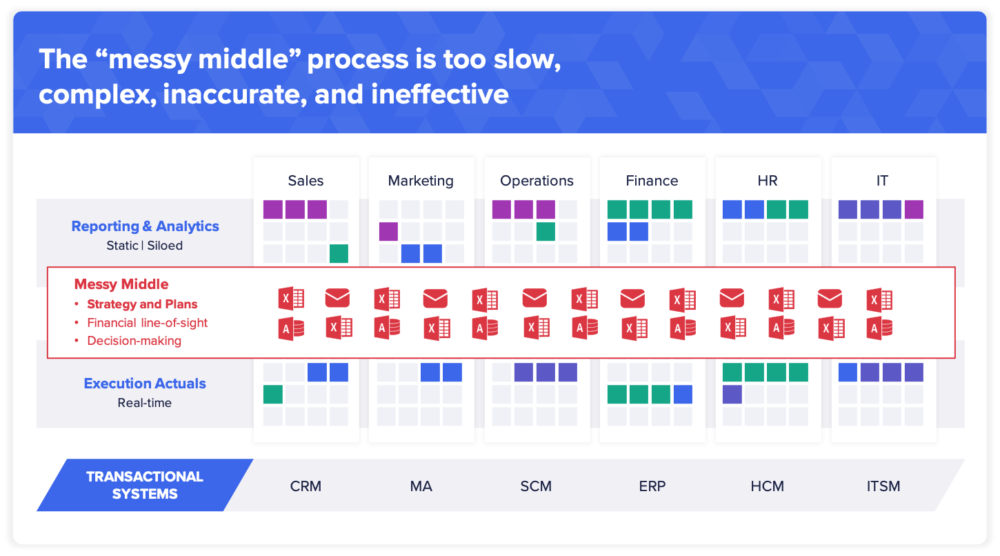What is Anaplan? And how does it exemplify Connected Planning?


Learn how Anaplan integrates planning, budgeting, and forecasting processes to provide an organization with real-time visibility into data that drives results.
The planning disconnect
Every time a new year begins, many of us take it as an opportunity to reorder our lives. Reorganize closets or refrigerators, create an emergency go-bag, get ahead of tax planning so that the weekend before the filing deadline you’re not frantically pawing through a year’s worth of receipts – you get the picture.
But often, these good intentions get bogged down by visibility issues such as, How will I know what’s in the fridge, so I don’t waste the fancy heirloom vegetables I bought last Sunday at the farmer’s market? Or How should I be organizing my tax paperwork so I can find everything easily when I need it? Another year rolls around and you’re still running your household off sticky notes and shoeboxes full of receipts. (As T.S. Eliot observed, Between the idea and the reality/ Between the motion and the act/ Falls the Shadow.)
You might feel a little better to know even large organizations struggle with similar issues. Yes, they may have million-dollar budgets for enterprise applications that run their actual lines of business – ERP, supply chain, HR, and sales planning, even point-of-sale or factory floor devices issuing gigabytes of real-time updates. And many of them also have on top of those functional applications a layer of business intelligence (BI) or analytics tools that aggregate and organize the line-of-business data into sleek dashboards and reports, intended to show how the company is performing and to guide strategic decisions.
However, there’s still a disconnect between the two layers. Data from all those enterprise applications may be issued in various rates or formats, or even answering entirely different questions. So it can’t be shared seamlessly between different departments or functions, let alone with the analytics tools. Instead, line-of-business managers have to manually gather the answers they need into spreadsheets or databases, then use those to feed the BI reports. This can lead to a proliferation of spreadsheets containing data that’s often incompatible or outdated (not to mention a lot of extra time and effort).
Anaplan replaces the mess in the middle
This is where Anaplan is useful – in the “messy middle” between functional applications and analytic tools. Anaplan’s cloud-based planning platform lets you create a shareable, real-time model of how your business actually works. You can build and test scenarios to illuminate blind spots and hidden opportunities. The models directly connect operational data to BI dashboards and analytics, letting you nimbly tailor strategy to desired outcomes.
For example, let’s take a department store chain, aiming to stay profitable in a fast-changing retail landscape. Each function has its own business processes, automated by different sets of applications.
Its operations include demand planning, to anticipate what customers are likely to want over the next 12 months; merchandising, to organize marketing campaigns; supply chain planning, to source and schedule delivery of the clothes, accessories, and home goods it will sell; HR, to manage thousands of store associates, warehouse workers, and so forth; facilities management, to keep stores safe and attractive; incentive planning, to motivate salespeople; customer service, to satisfy all buyers; and finance, to make sure everyone gets paid and the company’s money is being managed to best advantage.

Naturally, each of these functions has its own enterprise application – maybe several. Here’s how the Anaplan platform can help generate, test, and refine the assumptions that drive the instructions you give the transactional systems, and steer the organization towards minimizing risk and maximizing profit.
Demand planning and sales
The fundamental question in just about any industry is: What does the customer want to buy? That’s tricky in a field where demand can change overnight with the whims of fashion – or the latest health news. Anaplan provides a line of sight to all relevant internal and external factors, to meet demand nimbly and build better-targeted sales incentives.
Supply chain
Anaplan’s hyperscale Optimizer tools offer real-time, end-to-end visibility and “what-if” scenario planning to ensure an accurate supply forecast across your entire network. You can empower teams, including suppliers and other network partners, to collaborate across your business. Avoid outages, unsold inventory, and wasted investments.
HR and workforce optimization
Conventional HR packages handle the daily routines for employees – hours, benefits, payroll, compliance, and so forth. But they’re not typically built to consider larger issues of whether you have the right workforce as needs change (whether for temporary holiday help, or for experts in, say, furnishing a home office/classroom/yoga studio). Anaplan helps you build workforce readiness by connecting HR, finance, business data, and third-party sources to plan and model a range of workforce and talent strategies and scenarios.
Finance
Traditional financial planning is often too slow, rigid, and fragmented for today’s volatile conditions. Anaplan for Finance helps you link strategy to execution and speed up response time by connecting financial and operational plans, such as capital expenditure and facility plans. It supports a wide range of financial functions, including budgets, forecasts, analyses, profitability and pricing optimization, and automated cost management. You can implement unlimited finance use cases with seamless connection.
Add the power of predictive AI to your plans
And now, Anaplan leverages artificial intelligence and machine learning for richer analysis of the valuable data you collect across your company. Our AI-based predictive intelligence tools can integrate signals from within your business with worldwide inputs to uncover hidden possibilities and actionable directions.
The “messy middle” arises when you don’t have a single source of the truth that can be consulted everywhere from the C-suite to ordinary users’ cubicles. Anaplan can eliminate confusion and redundant work with a highly scalable, responsive, connected system of record that’s reliable, accurate, and traceable, for swift execution and accountability. It eliminates organizational silos and seamlessly incorporates internal and external factors across all your functions and departments, helping you make better decisions.
To learn more about how easily Anaplan integrates with major enterprise technology platforms such as Google Cloud, ServiceNow, Salesforce, and Adobe, for an agile, end-to-end approach to planning and forecasting, check out this white paper from Deloitte.